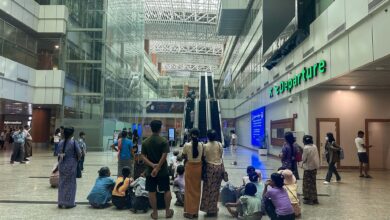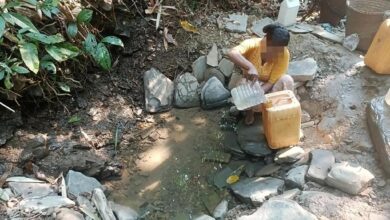
Pyae Phyo Aung was nervous as the police vehicle that was taking him back to Mandalay’s Obo Prison approached the southern entrance to Myanmar’s second-largest city on the morning of September 29.
Like some of his fellow passengers, he had heard that there was a plan to rescue him and several others aboard the vehicle—four who were members of the anti-regime People’s Defence Force (PDF), like himself, and three political prisoners.
But they were not alone in the back of the large van that was making the hour-long drive from Kyaukse, where they had been held at the local police station for several days while they attended court hearings. Besides a half dozen or so regular convicts, there were also two armed police officers sitting there with them, ready to open fire if necessary.
To make matters worse, Pyae Phyo Aung—who was just 19 years old—knew that he would have trouble escaping with his feet in shackles. But still, he believed that his comrades would somehow manage to pull off a daring rescue.
What he and the others were waiting for was the sound of someone banging twice on the side of the truck. That was the signal to duck.
It was at the Myitnge bridge, just a short distance south of the entrance to Mandalay, that they heard the signal at around 8am. With their heads held down, they listened as a barrage of bullets brought the van to a halt.
“The gunshots started as soon as we got across the Myintge bridge,” Pyae Phyo Aung recalled, speaking to Myanmar Now from a liberated area. “The two police in the back were killed right away. Another one in the front was injured. It was at this point that we decided to run.”
According to Pyae Phyo Aung, the two policemen in the front—including the one who had been driving—also opened fire and kept shooting until they ran out of ammunition. When one of them tried to escape, he was shot right away. “We saw blood on his stomach and thighs,” he said.
All of the political prisoners tried to flee, but in the end, only two, including Pyae Phyo Aung, made it.
What stopped the others was a combination of the sheer chaos of the situation and some bad luck, in the form of the sudden appearance of another police vehicle that arrived soon after the shooting started.
Pyae Phyo Aung and the other prisoner who escaped also barely got out of alive.
“The police officer in the other car fired at us. He hit me in the arm and the other guy in the leg. But we didn’t stop running, even though it was difficult with the shackles on. Somehow, we made it to the rescue team and got away,” he said.
But the others were not so fortunate.
“The two of us who escaped ran west, but the other six went in the opposite direction. The police went after them because they thought they had weapons. Four were captured on the spot, and the other two were caught some distance away,” said Pyae Phyo Aung.
The fate of those who failed to get away—including one who was “like a brother” to Pyae Phyo Aung—is still not known.
Ready to die
The plot to rescue the five PDF members started to take shape in April, soon after they were arrested, according to Nay Lin, an officer of the Truth Keeping Force, an anti-regime group based in Mandalay’s Amarapura Township.
“We kept them under constant watch and gathered as much intel as we could. We only launched the attack when we were sure that we would succeed. On the evening of September 28, we finally decide to carry out our mission with the help of the Myitnge PDF,” he said.
When the day came, the two resistance forces struck hard and fast, but soon found themselves coming under heavy fire.
“The police in the front seat fired first, and then the one in the other vehicle let loose as well. They were both shooting non-stop with G3 automatic rifles. After they lost some of their men, they started firing wildly, not caring who they hit. It was very fortunate that no civilians were injured,” said Nay Lin.
By the time around 200 soldiers arrived on the scene to conduct searches and impose a curfew on Myitnge, Pyae Phyo Aung and the other PDF members were long gone.
On April 18, Pyae Phyo Aung was one of the unlucky ones. He and his four comrades, who also hailed from Amarapura, were caught in their hideout “due to our own negligence,” he said. Those who didn’t get away were sent to an interrogation centre, where they were held for the next six days.
“The beatings started right away. It was at the interrogation centre that I learned that five of us had been arrested. Six people, armed with batons, swords and bats wrapped in barbed wires, laid into us. They also stabbed us in the thighs and did other things,” said Pyae Phyo Aung.
“One guy passed out, and we thought he had died. I figured we were all going to die. I accepted my fate. All I wanted was for someone to shoot me and end it,” he recalled.
Eventually they were charged with illegal possession of weapons and robbery—the latter crime being related to a raid the group had carried out against an Electric Power Corporation office.
In May, after they were found guilty on these and other charges laid against them in other townships, they were transferred to the notorious Obo Prison, located on the northern outskirts of Mandalay.

Solidarity behind bars
Inside Obo Prison, Pyae Phyo Aung learned that the brutality was far from over. Although he wasn’t personally subjected to some of the worst abuses, he said he heard about other prisoners who were.
“I didn’t experience it first hand, but some political prisoners were savagely beaten for going on hunger strikes and singing political songs. Around 50 or 100 fully armed prison guards struck them relentlessly while they were forced to sit in stress positions. Some had their teeth knocked out and others were left for dead in a puddle of their own blood. I heard some even died there,” he said.
One of these incidents was related to the execution in July of four activists, including veteran student leader Ko Jimmy and former lawmaker and hip-hop artist Phyo Zayar Thaw. In defiance, many political prisoners staged a hunger strike to protest this escalation of the regime’s war on its opponents.
“The prison authorities were just waiting for an opportunity to torture the prisoners, and the strike gave them the excuse they needed to start beating on them,” said Pyae Phyo Aung.
Dozens of prisoners were assaulted for taking part in the strike, including prominent student activist Naung Htet Aung, who was among 19 who were also placed in solitary confinement—in tiny, airless cells with very little light—as part of the crackdown.
“There was also a conflict over letters to the prisoners. The prisoners who protested were beaten with batons and some could no longer walk after being kicked down the stairs,” Pyae Phyo Aung recalled.
These actions were carried out systematically by prison guards who were, in fact, under military command.
“The wardens are all military personnel, which means the prison is run by the military. The political prisoners only had each other for support. I made some really good friends there,” Pyae Phyo Aung said of his time behind bars.
But while this strong sense of solidarity helped him survive life as a prisoner, it has also made it painful for him to think about his three comrades who did not get away.
“The military used lethal force when they were trying to catch us. Even if my friends are still alive, I’m sure they are being tortured. I’m very worried for their lives,” he said.
Regarding his own mistreatment at the hands of the military, he said that it no longer mattered to him.
“I think of myself as already dead, so I don’t feel bad about anything that was done to me. I just wish all of us had been rescued,” said Pyae Phyo Aung.



